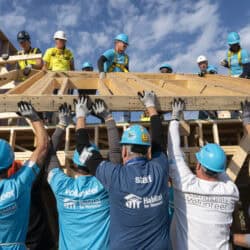The seed for a more self-sufficient and resilient economy, one not focused on extraction and exploitation, lies in community wealth building – and non-profits are on the front lines leading the way.
Buy Canadian.
The escalating trade tensions between Canada and the United States have ignited a new wave of Canadian patriotism. Consumers are consciously choosing made-in-Canada products as an act of national pride, while governments of all levels are adjusting their procurement policies to support “Team Canada.” For example, Ontario municipalities, such as Aurora, Brampton, Vaughan, and Toronto, are banning US-based companies from bidding on municipal contracts and instead focusing on procuring locally to support Canadian industries, workers, and communities. The Ontario government has put in place a “Procurement Restriction Policy” that restricts US businesses from participating in provincial government procurements, including hospitals, universities, and school boards.
Where we spend our money matters
When goods and services are procured locally, it keeps money, assets, jobs, and resources flowing locally. A 2019 report based in British Columbia found that for every $100 spent with a local independent office-supply business, $63 is reinvested locally. On the other hand, for every $100 spent with a big-box corporation, only $14 is reinvested locally. On a $1-million contract, local suppliers create 3.6 jobs, compared to only 1.8 to 2 jobs with multinational corporations.
“Buy local” is not a new idea, but to have economic activities produce additional benefits, such as social, cultural, and environmental benefits, is still relatively new to the Western world. Indigenous communities have been practising economic development rooted in reciprocity and circularity since time immemorial. Indigenous economies recognize that economic-development activities affect people and the planet. They prioritize sustainability to ensure that resources regenerate for future generations, in stark contrast to Western economic models that prioritize the accumulation of wealth.
Indigenous communities have been practising economic development rooted in reciprocity and circularity since time immemorial.
The crises that communities face today – affordability, precarious employment, failing social safety nets, and polarization, distrust, and apathy in our political institutions – are driven by the extractive and exploitative nature of our existing economic system. That looks like concentrated ownership; the financialization of housing, care, and food systems; community disinvestment; attacks on labour; environmental degradation from extractive practices; and racial injustice. Our economy is concentrating wealth in the hands of a tiny elite, while communities and workers pay the price. Non-profits know this well as they are on the front lines of addressing the symptoms of this broken economic system.
Regardless of what happens with the US tariffs, a seismic shift is already happening. Governments and the public are realizing that Canada needs to build a more self-sufficient and resilient economy.
To make the most of this shift, we need to do better. We know how to do better. Can we create an economy that keeps wealth in the hands of the people and communities that create it in the first place, an economy that moves away from extraction and exploitation?
Community wealth building
First articulated by the Democracy Collaborative in 2005, community wealth building means engaging in economic development in a way that is sustainable and permanently keeps resources within the community through enterprises that are local, democratic, and inclusive. While this is not a new idea, what is new about this framework is that it’s a movement that weaves together all the different components of inclusive local economic development.
There are five pillars of community wealth building:
- progressive procurement
- locally rooted finance
- inclusive and democratic enterprise
- fair work
- just use of land and property
Non-profits are leading the way in building community wealth
Fortunately, community-wealth-building movements are already established in Canada. From social enterprises, community benefits networks, and community land trusts, to ecosystem builders and policy and advocacy groups, non-profits and their communities are leading the way forward.
Across Canada, non-profit social enterprises and co-operatives are reimagining the way we do business by providing goods and services with additional public benefits, such as hiring and spending locally to ensure that dollars circulate within the local economy, particularly in rural and remote regions.
Across Ontario, community benefits networks are on the ground advocating for shared prosperity in their local communities through community benefits agreements (CBAs). From Toronto, Hamilton, and Peel, to Ottawa, Niagara, and Prince Edward County, these networks and coalitions ensure that when public infrastructure and construction projects take place in their neighbourhoods, the impacts of gentrification are mitigated and all residents benefit from the incoming economic opportunities. Current CBA campaigns include the $80-billion federal high-speed rail project, the Hamilton LRT, the Tunney’s Pasture redevelopment in Ottawa, and the Downsview redevelopment in Toronto.
Non-profits are also employing innovative models such as community land trusts (CLTs) to take land off the market and steward it for the benefit of local communities. With community control being at the heart of CLTs, they ensure that assets are “rooted in place” and not at risk of leaving the community, combatting displacement of residents and businesses. For example, the Ottawa Community Land Trust leveraged social finance and grants to acquire residential buildings, preserving existing affordable housing.
These organizations, and many similar ones across the country, are founded by groups of community members volunteering their time and resources. Despite having limited resources, they’ve still managed some big wins.
Nourishing new possibilities: A bold call to action for all
“Build back better” was a popular slogan during the COVID-19 pandemic. People saw the pandemic as both a wake-up call and an opportunity to do things differently, pitching ideas like equitable recovery, a green new deal, and a bolstered care economy to root out our rotting economic system. But we failed.
The tariff war once again reminds us that an alternative economy is needed, desired, and possible, but it needs to be nourished. Considering the complexity and scale of work required to create an alternative economic system, the movement needs to be resourced adequately to be sustained and scaled.
The tariff war once again reminds us that an alternative economy is needed, desired, and possible, but it needs to be nourished.
The rally call has already happened; the time is now for bold action. Nothing less will suffice.
Here are some ways to nourish the community-wealth-building movement:
- Reimagine the economy: Familiarize yourself with the principles and history of community wealth building, its different elements, and the organizations that are leading the work on the ground.
- Examine organizational procurement practices: Adopt social procurement.
- Revisit your investment strategies: Review where your reserves, endowments, savings, and more are invested.
- Advocate for enabling public policies: Recently, Scotland became the first country to introduce a national Community Wealth Building Bill. Leveraging the current “Buy Canadian” moment, different levels of government in Canada can do the same by partnering with non-profits to more actively build, expand, and invest in community-wealth-building activities to push back on the dominating extractive economic model.
- Resource the work: While public policy can create more space and opportunity for community-wealth-building activities, it alone is not sufficient to achieve desired outcomes. Community wealth building is multifaceted, and we need to resource the organizations that will do the heavy lifting like advocating, convening, negotiating, and building the movement, including funding the emergence of new movements.
- Nourish the whole ecosystem: Rather than cherry-pick organizations or issues based on what funders deem to be priorities at any given moment, the entire ecosystem needs to be supported – so the different elements can work together in synergy. Social enterprises and their incubators, community benefits coalitions, community land trusts, community finance intermediaries, and advocates and ecosystem builders all play a crucial role.
Now is the time to go big, not back down. The seed for an alternative economy has already been planted; let’s ensure that we provide it the proper care and nutrients it needs so it can flourish and bloom into a better future for all.


